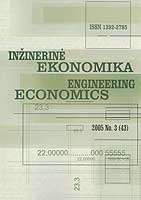Integration of Sustainable Development Indicators into Sustainable Development Programmes
Integration of Sustainable Development Indicators into Sustainable Development Programmes
Author(s): Remigijus Čiegis, Dalia StreimikieneSubject(s): Energy and Environmental Studies, Economic policy, Methodology and research technology, Economic development
Published by: Kauno Technologijos Universitetas
Keywords: sustainable development; sustainable energy; sustainable development indicators;
Summary/Abstract: The article deals with some theoretical aspects of society sustainable development management and discusses issues of integration of sustainable development indicators into preparation of sustainable development strategies. The article discuses economic growth and its impact of environmental pollution and income inequality. The idea of economic growth positive impact on sustainable development was elaborated by proposing implementation of environmental and social policies into economic development strategies. The Kuznets classical and environmental curves were discussed based on recent publications analyzing the relationship between income and pollution as well income and inequality. Using theoretical approach the main requirements for sustainable economic development management system were formed. Indicators approach for the development of sustainable energy programmes was elaborated. Indicators simplify information on complex phenomena and reduce information to the most important elements. Indicators also allow targeted data and information searches and the assessment of conditions and trends in relation to goals and targets. Sustainable development indicators are grouped according the main dimensions of sustainable development: economic, social and environmental. 5 types of indicators are widely recognized: pressure indicators refer to direct stress factors, which human activities place on the environment. State indicators refer to the current conditions. Response indicators refer to the measurable aspects of policies developed by the society. Driving force indicators refer to socio-economic or socio-cultural factors driving activities that increase or mitigate the pressure on the environment. Impact indicators refer to effects caused by environmental conditions. Sometimes it is difficult to distinguish between state and impact indicators. Three principles in application of indicators approach were discussed and the proposals for the integration of indicators into national planning systems were developed based on the structure of National sustainable development strategy for Lithuania. Application of indicators of sustainable energy development in national energy strategy illustrated theretofore described approach. The main principles of sustainable development are integrated in National sustainable development strategy. This strategy includes 6 branches of economy (transport, industry, energy, agriculture, household, tourism), 4 environmental sectors (air, water, biodiversity and waste), 4 main social aspects (employment, poverty and health, education, cultural identity) and regional development issues. All these economic, social, environmental and regional development issues are presented in close integrity. Indicators for some branches and environmental sectors were proposed in the strategy but interlinkages and the consistent framework of indicators for monitoring progress towards all goals established in the strategy wasn’t performed. The article presents new approach for the selection of appropriate indicators and integration of them into sustainable development strategies. This approach is based on idea that all the main sustainable development indicators are related to each other through the chain of impacts. Economic indicators have direct impact on social and environmental indicators therefore the main response actions or new policies should be implemented on the main driving force indicators of economic dimension.
Journal: Engineering Economics
- Issue Year: 2005
- Issue No: 2 (42)
- Page Range: 7-12
- Page Count: 6
- Language: English

